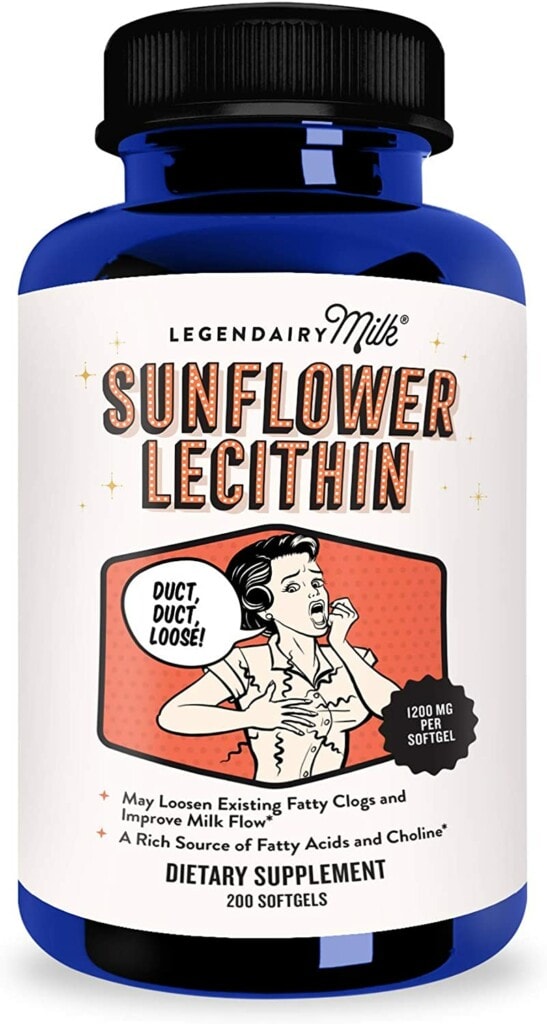When it comes to breastfeeding, challenges seem to pop up at the most inconvenient times. Mastitis, plugged ducts, or sore nipples are nothing a new mom wants to deal with. But knowing about possible challenges you may encounter will help you be ready if you run into any problems.
One situation you could find yourself in is having a plugged or clogged milk duct. A plugged milk duct isn’t uncommon for a breastfeeding mom but can bring discomfort and pain or lead to mastitis. You can try a handful of methods to prevent and treat plugged milk ducts, and one method to consider is the use of sunflower lecithin.1 While not commonly discussed, sunflower lecithin could benefit your breastfeeding journey.
What is Lecithin?
Lecithin is a fatty molecule the body uses in many functions to maintain health. It is in plants and animal tissue, and experts believe it works as a natural emulsifier. Supplemental and dietary additive lecithin is frequently sourced from egg yolks, soybeans, and sunflower seeds.2,7 You can find lecithin as an additive in many foods you are already eating. Cosmetic companies even frequently use lecithin in the process of making many cosmetics.8
Lecithin is a supplement throughout the medical world, and it may play a beneficial role in many different areas of health. It supports immune function, brain health and development, cardiovascular health, and breastfeeding support.2
Sunflower Lecithin and Breastfeeding
Regarding breastfeeding support, specifically for plugged milk ducts, your healthcare team may recommend sunflower lecithin. It can be used as a dietary supplement and is very helpful in preventing recurrent plugged milk ducts in breastfeeding mothers. Although there is no direct research to back its use, sunflower lecithin can help make breast milk “less sticky.” It decreases the viscosity of milk and works as a preventative and supportive measure for plugged milk ducts for some breastfeeding women.3
By decreasing the viscosity of breast milk, it can flow and pass through your ducts more easily. And this lowers your risk of plugged ducts.3 Medical experts have suggested sunflower lecithin as a treatment for mothers experiencing mastitis because it can help with inflammation and emulsifies breast milk.5
Although sunflower lecithin is not usually the first line of prevention for a plugged milk duct, it may be something to consider if you repeatedly have the same concern.1 Sunflower lecithin is recognized as a generally safe maternal supplementation and is usually well tolerated.4 For dosing information, please speak with your healthcare team and take it as instructed.
Different Ways to Take Sunflower Lecithin
Many believe sunflower lecithin is a “better” source of lecithin.2,6 Its good reputation is because sunflower seeds are not genetically modified, and the extraction process does not require harsh chemicals like other lecithin sources.
Sunflower lecithin comes in a few different forms. There are powders, capsules, granules, and liquids.7 All are good options, but they have differences in how you take them. Let’s review the different types of sunflower lecithin on the market and common directions for use. But remember, it is always important to thoroughly read the label for instructions on how to take any supplement:
- Capsules: Take the dose as directed with food and water.
- Liquid: Take the dose as directed. You can add the liquid to your drink of choice.
- Granule: Take the dose as directed, mix it into a drink of choice or sprinkle it on top of food.
- Powder: Take the dose as directed, mix it into a drink of choice or sprinkle it on top of food.
It should be easy to find if you want to purchase sunflower lecithin. Most options will be available at a pharmacy, online, or at a health food store.6

Buy Here
When one problem after another arises, it feels defeating, and for many, that means weaning earlier than desired. But knowing options to discuss with your healthcare team could help you overcome your breastfeeding challenges and meet your goals for you and your little one.
Please don’t suffer alone if you face plugged duct after plugged duct. Instead, reach out to your healthcare team to find the best solution and plan for you and your little one. Who knows, maybe the answer will be sunflower lecithin. Keep up the great work, mama; breastfeeding isn’t always easy, but you are doing fantastic!
Resources
1. Wambach, K., & Riordan, J. (2016). Breastfeeding and human lactation. Jones & Bartlett.
2. Singh, S. (2021). Comparative Study Of Synthesis and Nutritional Aspects of Lecithin From Soy and Sunflower Oil. Annals of R.S.C.B., 25(6), 16356–16376.
3. https://www.canadianbreastfeedingfoundation.org/basics/shtml
4. Drugs and Lactation Database (LactMed) [Internet]. Bethesda (MD): National Library of Medicine (US); 2006-. Lecithin. [Updated 2022 Sep 19].
5. https://doi.org/10.1089/bfm.2022.29207.kbm
6. https://draxe.com/nutrition/#2541888
7. https://www.urmc.rochester.edu/encyclopedia/content.aspx
8. https://pubmed.ncbi.nlm.nih.gov/11358109/
This article contains affiliate links. These opinions are our own. However, if you buy something, we may earn a small commission, which helps us keep our content free to our readers. Check out our Chick Picks Shop to see more of our recommended products. It’s our carefully curated shop of products we love and recommend! ❤️

 PARENTING TIPS
PARENTING TIPS PREGNANCY
PREGNANCY BABY CARE
BABY CARE TODDLERS
TODDLERS TEENS
TEENS HEALTH CARE
HEALTH CARE ACTIVITIES & CRAFTS
ACTIVITIES & CRAFTS


